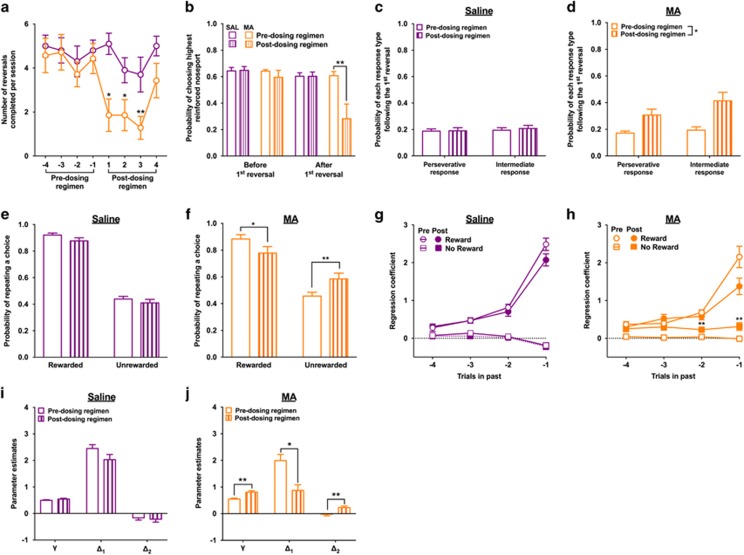Figure 2.
The effects of the dosing regimen (MA: orange/light grey; saline: purple/black) on decision-making processes in the variable PRL. (a) Exposure to MA reduced the number of reversals that rats completed in each session. This decision-making impairment was observed during the first 3 weeks of forced abstinence, but had returned to levels comparable to that before the dosing regimen after 4 weeks of abstinence from MA. (b) MA-induced decision-making deficits were not because of impairments in the ability of rats to acquire the initial discrimination, but in their ability to adaptively modify their decisions when the reinforcement probabilities reversed. (c) Exposure to saline did not alter the types of errors rats made following the first reversal, but (d) exposure to MA increased the percentage of trials in which rats chose the noseport that was initially associated with the highest probability of reinforcement (eg, perseverative response) and the noseport that was associated with the intermediate probability of reinforcement (eg, intermediate response). (e) Exposure to saline did not alter feedback-based responding, but (f) exposure to MA decreased the probability that rats would persist with a response following a choice that resulted in reward and increased the probability that rats would persist with a response following a choice that was not rewarded. (g, h) Before the dosing regimen, rats were more likely to make the same choice that was rewarded and less likely to make the same choice that was not rewarded in recent trials. (h) Exposure to MA did not significantly alter the influence of recently rewarded choices on current choice, but increased the influence of recently unrewarded choices on current choice. (i) Exposure to saline did not alter the reinforcement-learning parameters. (j) Exposure to MA increased the γ parameter, decreased the Δ1 parameter, and increased the Δ2 parameter; *p<0.05 and **p<0.01. A full color version of this figure is available at the Neuropsychopharmacology journal online.

